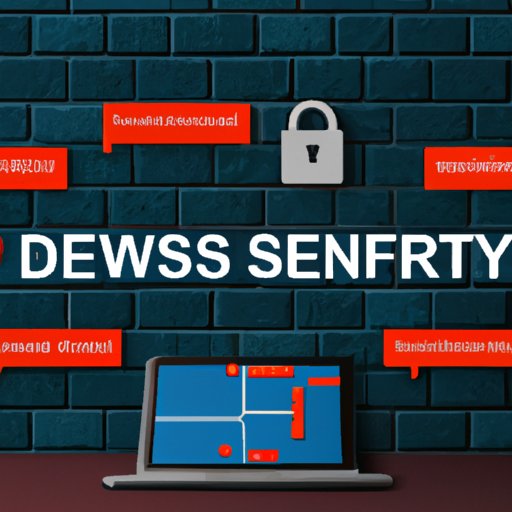Introduction
Cybersecurity is an increasingly important topic in today’s digital age. With more organizations relying on the internet for their operations, there is a growing need for robust cybersecurity solutions to protect against cyber threats. But what exactly is cybersecurity and how does it work? In this article, we will explore the different components of cybersecurity, the types of cyberattacks, and the steps necessary to protect against them.
Exploring the Different Components of Cybersecurity
Cybersecurity is the practice of protecting networks, systems, and programs from digital attacks. These attacks are usually aimed at accessing, changing, or destroying sensitive information, extorting money from users, or interrupting normal business processes. To prevent these attacks, organizations must implement a range of security solutions such as firewalls, network security, data encryption, access control, and web application security.

Examining the Role of Firewalls in Cybersecurity
Firewalls are one of the most important components of any cybersecurity solution. They act as a barrier between trusted internal networks and untrusted external networks, controlling the flow of traffic based on a set of predetermined rules. Firewalls come in two main types: hardware firewalls and software firewalls. Hardware firewalls are physical devices installed on the network, while software firewalls are installed directly onto computers.
The benefits of firewall protection include enhanced security, improved compliance with industry regulations, and cost savings. Firewalls help protect against malicious attacks by blocking unauthorized access and monitoring network activity. They can also help detect and prevent data breaches, which can save organizations from costly fines and reputational damage.

Investigating the Types of Cyberattacks and Their Prevention
There are many different types of cyberattacks that organizations must be aware of and guard against. Common types of cyberattacks include malware, phishing, and denial of service (DoS) attacks. Malware is malicious software designed to gain access to a system without the user’s knowledge or permission. Phishing is an attempt to acquire sensitive information such as usernames and passwords through fraudulent emails or websites. DoS attacks involve flooding a server or network with requests, resulting in a disruption of service.
Organizations can take several steps to protect against cyberattacks. These include implementing strong authentication methods, regularly patching and updating software, and using antivirus software. Additionally, organizations should educate employees on best practices for recognizing and avoiding potential cyber threats.
Understanding the Benefits of Cybersecurity Solutions
Cybersecurity solutions can provide a number of benefits to organizations, including improved security, reduced costs, and enhanced compliance. By implementing the right security solutions, organizations can protect their data and systems from malicious attacks. This can result in fewer data breaches and less downtime, which can save organizations time and money in the long run. Additionally, with the right security measures in place, organizations can ensure they are compliant with industry regulations.
Analyzing the Impact of Social Engineering on Cybersecurity
Social engineering is another type of attack that organizations should be aware of. This involves manipulating people into revealing confidential information or performing actions that are beneficial to the attacker. Common techniques used in social engineering attacks include pretexting, baiting, and tailgating. Pretexting involves creating a false identity to gain access to sensitive information, while baiting involves enticing victims with free items or services.
Organizations can improve their social engineering prevention efforts by implementing strong authentication methods, educating employees on the dangers of social engineering, and regularly testing their systems for vulnerabilities. Additionally, organizations should have policies in place to ensure that all employees are aware of the risks associated with social engineering attacks.

Evaluating the Necessity of Cybersecurity Training and Education
In addition to implementing security solutions, organizations must also invest in cybersecurity training and education. This will ensure that employees are aware of the latest security threats and understand how to recognize and respond to them. Cybersecurity training can also help organizations identify weaknesses in their security posture and develop strategies to address them.
Organizations should consider implementing an ongoing cybersecurity training program for all employees. This should include regular assessments, simulations, and tutorials to ensure that employees remain up-to-date on the latest threats and best practices for preventing them. Additionally, organizations should create a culture of security awareness by encouraging employees to report any suspicious activity or potential security incidents.
Conclusion
Cybersecurity is an essential component of any organization’s security posture. Organizations must implement a range of security solutions, such as firewalls, network security, data encryption, access control, and web application security, to protect against cyberattacks. Additionally, organizations should invest in cybersecurity training and education to ensure that employees are aware of the latest threats and how to respond to them. By taking the necessary steps to protect against cyber threats, organizations can improve their security posture and reduce the risk of costly data breaches.
Key Takeaways
Cybersecurity is an important practice that organizations must invest in to protect against cyberattacks. Firewalls, network security, data encryption, access control, and web application security are all important components of a robust cybersecurity solution. Additionally, organizations should educate employees on potential threats and invest in cybersecurity training to ensure they remain up-to-date on the latest security trends.
(Note: Is this article not meeting your expectations? Do you have knowledge or insights to share? Unlock new opportunities and expand your reach by joining our authors team. Click Registration to join us and share your expertise with our readers.)
